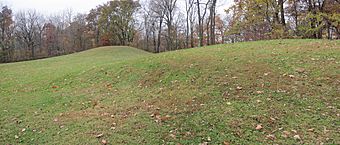Toolesboro Mound Group facts for kids
|
Toolesboro Mound Group
|
|
 |
|
| Nearest city | Toolesboro, Iowa |
|---|---|
| NRHP reference No. | 66000337 |
Quick facts for kids Significant dates |
|
| Added to NRHP | October 15, 1966 |
| Designated NHL | May 23, 1966 |
The Toolesboro Mound Group is a special place in Iowa. It is a collection of ancient earth mounds built by the Havana Hopewell culture. These mounds are located on the north bank of the Iowa River, close to where it flows into the mighty Mississippi River.
This site is so important that it is recognized as a National Historic Landmark. The State Historical Society of Iowa now owns and cares for these mounds. They are open for everyone to visit and learn about. You can find the mounds east of Wapello, Iowa, near the small community of Toolesboro.
Contents
Who Were the Hopewell People?
The Hopewell culture was a group of Native American people. They lived in the Midwest of North America a very long time ago. They were skilled at hunting and gathering food. The area around the Iowa and Mississippi rivers was perfect for them. It had rich soil for wild plants, and the rivers provided fish, shellfish, and waterfowl.
The Hopewell people were known for their impressive earth mounds. They built these mounds to bury their dead. Inside the mounds, they often placed special items called grave goods. These items showed how important the person was in their community. They might have also shown their religious or social leadership.
What Did the Hopewell Trade?
The Hopewell people had a huge trading network. They exchanged valuable goods across vast distances. This network is sometimes called the "Hopewell Interaction Sphere."
For example, they found copper from Lake Superior far to the north. They also had sea shells that came all the way from the Gulf of Mexico. Mica, a shiny mineral, traveled from the Appalachian Mountains. Even obsidian, a volcanic glass, came from the area that is now Yellowstone National Park.
The Hopewell people in the Toolesboro area also had their own valuable goods to trade. They made sharp blades from local flint. They also collected beautiful freshwater pearls. These pearls were highly prized and traded far and wide.
Building the Toolesboro Mounds
The mounds at Toolesboro were built by the Havana Hopewell culture. This happened between about 200 BCE and 100 CE. That means they were built over 2,000 years ago!
The important items found in the mounds tell us that the Hopewell community was well-organized. They had a clear social structure, with leaders and important people. It is likely that a Hopewell village was located nearby. However, archaeologists have not yet found it. The Iowa River has changed its path many times over thousands of years. It might have covered or buried the ancient village with silt.
Later Visitors to the Site
After the Hopewell people, other groups also used the area. Close to the mounds, there is another earthwork. It was once thought to be part of the Hopewell site. However, experts now believe it was built much later. It might have been made by a different Native American group called the Oneota. There are other Oneota sites nearby, which supports this idea.
Protecting These Ancient Treasures
When Americans first explored the Mississippi Valley, they found many Hopewell mounds. Sadly, most of them were destroyed. Some were damaged by people digging carelessly. Others were lost to grave robbers or farming plows.
In the late 1800s, the Toolesboro Mound Group was dug up by the Davenport Academy of Natural Sciences. They found some artifacts, but the digging was not done carefully.
Early records show there might have been as many as 12 mounds near Toolesboro. Today, only seven remain. The Mosier family, who owned the land, generously gave it to the state of Iowa. In 1966, the Toolesboro Mound Group became a National Historic Landmark. A small visitor center and parking lot were built in 1969. The State Historical Society of Iowa now looks after the site.
Of the seven mounds, two are easy to see at the Educational Center. The other five are in a nearby wooded area. A fence separates them from the center.
The Toolesboro Mound Group is a sacred burial site for Native Americans. Visitors are welcome to learn about this important history. Please remember not to walk on or near the mounds themselves. This helps protect them for future generations.
The site's address is 6568 Toolesboro Road, Wapello, Iowa.
See Also

